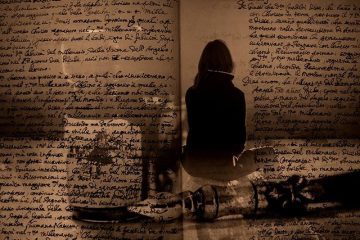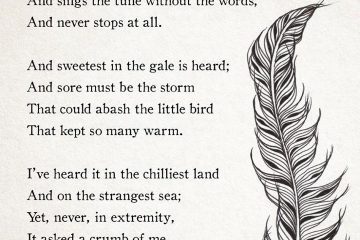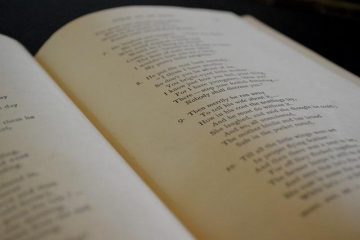Table of Contents
- Understanding the Symbolism of the Raven in Poes Masterpiece
- Exploring the Themes of Grief and Loss in The Raven
- Analyzing the Structure and Form of The Raven
- The Impact of The Raven on American Literature
- Tips for Readers to Engage with The Raven on a Deeper Level
- Q&A
- In Summary


Understanding the Symbolism of the Raven in Poes Masterpiece
The raven in Edgar Allan Poe’s poem serves as a powerful emblem of despair and lost hope. Through its repeated refrain of “Nevermore,” the bird embodies the haunting persistence of grief. This enigmatic creature transcends its mere appearance, transforming into a spectral reminder of the protagonist’s inner turmoil. The choice of a raven, a bird often associated with death and the supernatural, accentuates the creepy atmosphere that permeates the poem, enhancing the themes of mortality and madness.
Moreover, the raven can be seen as a complex representation of knowledge and wisdom, albeit a dark and unwanted form. In various cultures, ravens are revered as symbols of prophecy and intelligence. In “The Raven,” its ominous presence invites the narrator to confront uncomfortable truths about his own psyche and the nature of existence. As the narrator spirals deeper into despair, the raven’s presence grows increasingly significant, suggesting that with knowledge often comes a heavy burden — that of accepting irreversible loss.
In the broader context of literature, the raven can symbolize the inevitability of fate. It serves as a reminder that some aspects of life, especially grief and longing, are inescapable. The dynamic relationship between the narrator and the raven compels readers to consider their interpretations of mortality and memory. Through its chilling message, the raven elevates the poem from a tale of sorrow to a reflection on the profound entanglements of human emotion and the essence of being.


Exploring the Themes of Grief and Loss in The Raven
Edgar Allan Poe’s masterful use of imagery and sound immerses readers in a profound exploration of emotional turmoil. The poem’s narrator grapples with the deep sorrow of losing a loved one, symbolized powerfully through the recurring presence of the raven. This enigmatic bird serves as a constant reminder of the narrator’s grief, echoing a sense of hopelessness that permeates the verses. As the creature perches itself upon the bust of Pallas, it signifies an inescapable reality: the permanence of loss and the inevitability of death.
The interplay between memory and despair emerges as a pivotal theme throughout the poem. The narrator’s initial nostalgia transforms into anguish as he is haunted by memories of Lenore, the lost beloved. The repetition of the word “nevermore” not only emphasizes the finality of death but also highlights the incessant nature of mourning. Each time the raven speaks, it reinforces the absence felt by the narrator, unraveling his sanity and plunging him into deeper and darker reflections on the nature of existence.
Furthermore, the poem poignantly addresses the struggle between acceptance and denial in the face of grief. The narrator oscillates between yearning for solace and clinging desperately to the whispers of a bygone love. This struggle is encapsulated in the stark contrast between light and darkness throughout the poem, suggesting that while moments of light may still exist, they are overshadowed by the heavy burden of loss. As the tale unfolds, Poe reminds us that grief is not merely an emotional state but a complex journey that can entrap souls in an eternal cycle of longing.


Analyzing the Structure and Form of The Raven
Edgar Allan Poe’s acclaimed poem is notable for its intricate structure and rhythmic form, which effectively contribute to its haunting atmosphere. The poem follows a consistent meter, adhering to a trochaic octameter, that creates a sense of inevitability and urgency. Each stanza comprises six lines—five of which maintain a rhyme scheme of ABCBBB, while the final line echoes the initial theme introduced in the stanza. This repetitive form mirrors the obsessive nature of the narrator’s thoughts, drawing readers deeper into his melancholic turmoil.
The use of internal rhyme is another prominent feature that enhances the poem’s musicality. By incorporating rhymes within lines, Poe elevates the emotional resonance and flow of the narrative. For instance, words like “dream” and “stream” interlace seamlessly, producing a rhythm that captivates the reader while emphasizing pivotal elements in the text. Additionally, the recurring phrase “nevermore” serves as both a refrain and a psychological tether, anchoring the poem in the narrator’s despair and reinforcing the theme of irrevocable loss.
Moreover, the poem’s entire composition can be viewed as a dramatic monologue, where the speaker reveals his inner conflict and descent into madness. The dialogue between the narrator and the raven serves to externalize his struggle, with the bird symbolizing death and eternal memory. The interplay between light and dark symbolizes hope and despair, with the raven itself embodying the inescapable nature of grief. These layers of meaning are meticulously woven into the fabric of the poem, making it a timeless exploration of the human experience in the face of mortality.


The Impact of The Raven on American Literature
Edgar Allan Poe’s masterwork has undeniably left a profound mark on the landscape of American literature, serving not just as a pivotal text but also as a touchstone for many writers who followed. It embodies the quintessential themes of gothic fiction, exploring the depths of despair, madness, and obsession. The resonant refrain of the raven’s cry—“Nevermore”—has become an enduring symbol of loss and longing, influencing countless authors in their quests to explore similar emotional landscapes. Poe’s intricate use of meter and rhyme scheme has inspired a generation of poets to experiment with form and sound, advancing the art of poetry itself.
The poem’s rich imagery and psychological depth also paved the way for the modern psychological thriller genre, profoundly impacting writers like Robert Louis Stevenson and H.P. Lovecraft. Poe’s exploration of the inner workings of the human mind has prompted many literary scholars to reevaluate the boundaries of narrative perspective and character development. The intense atmosphere he creates within the confines of a single evening has encouraged authors to delve into themes of isolation and existential dread, shaping the ways narratives unfold in the American literary canon.
Moreover, “The Raven” has been instrumental in the evolution of American Romanticism, pushing the genre toward darker explorations of the human experience. Its embrace of the supernatural and the macabre has challenged preceding literary traditions, encouraging writers to embrace their own individualism and the deeper elements of human emotion. Many contemporary poets and novelists continue to draw on Poe’s legacy, excited by the complexities he introduced, as seen in modern interpretations and adaptations of his themes. In essence, the impact of this iconic poem extend far beyond its verses, transforming American literature at large into an arena where emotional truth and artistic exploration reign supreme.
Tips for Readers to Engage with The Raven on a Deeper Level
To truly appreciate the haunting beauty of this classic poem, consider immersing yourself in its rhythm and meter. Read the text aloud, allowing the musicality of Poe’s language to wash over you. Pay attention to the repetition and alliteration that create a mesmerizing effect. Try using different intonations for the Raven’s replies and the narrator’s pleas, which can bring forth new emotions and perspectives.
Another effective way to deepen your connection with the poem is by exploring its themes. The central motifs of grief, loss, and madness resonate universally. Reflect on how these themes relate to your own experiences or those of people around you. Consider creating a mood board or a mind map that highlights important feelings and symbols within the poem. This visual approach can help you form a personal link to the text and reveal nuances you may have missed at first glance.
Lastly, engage with the poem through multi-media exploration. Look up artistic interpretations, such as paintings, music, or film adaptations inspired by ”The Raven.” You could even start a discussion group or an online forum where readers share their insights and analyses of the poem. By exchanging interpretations, you’ll be able to uncover layers of meaning in a collaborative way, opening the door to countless possibilities and deepening your understanding of this timeless work.
Q&A
Q&A on Edgar Allan Poe’s “The Raven”
Q: What is the main theme of “The Raven”? A: The primary theme of “The Raven” revolves around grief and loss. The poem delves into the narrator’s descent into despair following the death of Lenore, his beloved. The recurring presence of the raven symbolizes the inescapability of sorrow and the haunting nature of memories.Q: Who is the narrator of “The Raven,” and what is his situation? A: The narrator is a nameless, melancholy man who mourns the loss of Lenore. He finds himself isolated in his chamber, surrounded by symbols of his loneliness and despair. As he contemplates his memories and struggles with his emotions, the sudden visit of the raven intensifies his inner turmoil.
Q: What role does the raven play in the poem? A: The raven serves as a powerful symbol of the narrator’s grief. Its repeated utterance of ”Nevermore” acts as a chilling reminder of the permanence of death and the futility of hope for reunion with Lenore. The bird transforms from a mere visitor to a dark omen, reflecting the narrator’s deteriorating mental state.
Q: How does Poe use language and structure to create an eerie atmosphere in “The Raven”? A: Poe employs a melodious rhythm and internal rhyme scheme to enhance the poem’s musical quality, contributing to its haunting atmosphere. The use of dark imagery, along with evocative language, draws readers into the narrator’s emotional landscape, making them feel the weight of his sorrow.
Q: What is the significance of the refrain “Nevermore”? A: The refrain “Nevermore” underscores the poem’s themes of hopelessness and finality. Each time the raven utters this word in response to the narrator’s questions, it reinforces the idea that certain losses are irrevocable and that striving for solace is ultimately in vain.
Q: How has “The Raven” influenced literature or popular culture? A: “The Raven” has left an indelible mark on literature and popular culture, inspiring countless adaptations, references, and imitations. Its exploration of dark themes and complex emotions has resonated with readers and artists alike, embedding it in the canon of Gothic literature and beyond.
Q: What can modern readers take away from “The Raven”? A: Modern readers can relate to the poem’s exploration of loss, memory, and the human psyche. It serves as a reminder of the universality of grief and the intricate ways we process sorrow. “The Raven” challenges us to confront our emotions and acknowledge the shadows that linger in our minds.




0 Comments